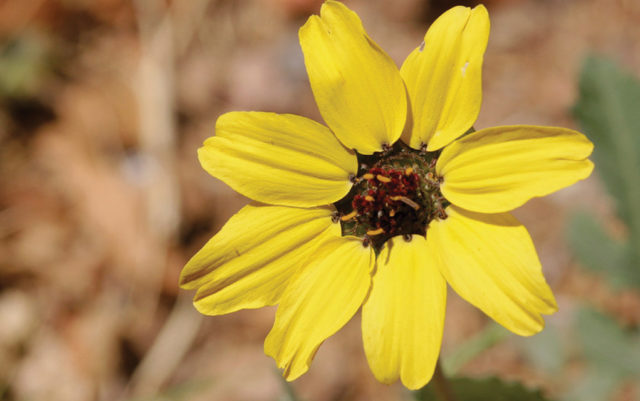
From the onset of the COVID pandemic, houseplant sales have skyrocketed. Nurseries and greenhouses across the country have struggled to keep up with the demand for succulents, spider plants and bonsai, plus rising demands for rare and one-of-a-kind houseplants.
In California, a prized succulent known as a liveforever grows naturally on the coastal cliffs. Unique species of these succulents, such as the Dudleya farinosa, fetch exorbitant prices, incentivizing poachers to dig them up for sale. As journalist Lois Beckett detailed in The Guardian, one of the most infamous succulent poachers, Byungsu Kim, illegally harvested over 3,700 dudleyas from California’s state parks during one excursion. The estimated value of the stolen succulents tallied up to $600,000, but the biodiversity loss caused by removing these plants extends at least 4 million years into the future, according to the educational U.K.-based YouTube channel Nature Bites.
“A hillside denuded of dudleya [can easily slough] off into the ocean,” Nick Jensen, conservation project manager at California Native Plant Society, told The Guardian. These collapsing cliffs put “lives, homes, and vital infrastructure at stake,” according to reporting in The Atlantic.
Poaching in the houseplant industry affects more than just California. In the American and Mexican Chihuahuan Desert—one of the most biologically diverse deserts in the world—landscapers and cacti collectors fuel the cacti smuggling business. In Mexico, the removal of wild cacti is often legal, but transportation across borders often is not, according to the World Wildlife Fund (WWF). Famous saguaro cacti, with their charismatic arms, have been dug up and sold, “leading to depletion of some cactus species in the Chihuahuan Desert,” botanist Christopher Robbins told WWF. Desert life like tortoises, deer, lizards, snakes, and coyotes all depend upon the cacti for water, shelter, and food.
California and the Chihuahuan Desert represent only a small portion of the illegal plant trade that’s spread all over the world. Rare succulents species from South Africa, carnivorous plants from South Carolina and Australia, medicinally valued orchids from India, and flowering plants such as the Begonia from the Philippines have all been poached to provide for the fast-growing houseplant industry. Each time one of these endangered plants disappears from nature, it accentuates the loss of biodiversity, negatively impacting our children and grandchildren. “The continuing loss of biodiversity [undermines] our ability for poverty reduction, food and water security, human health, and the overall goal of leaving nobody behind,” UN Biodiversity Chief Robert Watson told Deutsche Welle.
The growth of the illegal plant trade and consequently the loss in biodiversity has caused irreversible damage. To start, humans have only analyzed a small fraction of the world’s flora for potential uses. Every time a plant goes extinct, humanity loses the opportunity to uncover new plant-based medicines, or a revolutionary scientific discovery. In addition, the decrease in biodiversity also threatens life by causing disease to spread more rapidly.
Luckily, many countries have laws protecting some of these endangered plants, but the enforcement of these laws has proven both tricky and lacking. The opportunity for profit in plant poaching is high, and the repercussions if caught are low (mostly just fines), exacerbating the plant poaching boom over the past few years. Unfortunately, plant biodiversity conservation is not a primary concern for most countries. Some countries, such as Colombia, Venezuela and the Democratic Republic of the Congo, prioritize issues such as social unrest, deforestation (slash and burn), and curbing drug cartels over protecting endangered plants. The demand for these major issues to be solved first is undeniable, but if nothing is done to protect these scarce plants, our descendants will suffer. We are currently living through a mass extinction caused by humanity: “The global extinction rate today is tens to hundreds of times higher than its average over the past 10 million years,“ reports Deutsche Welle. If nothing is done, pandemics will become more common and more deadly, scientific and medicinal knowledge will be lost, and humans will be less prepared to sustain the needs of everyone.
You may be wondering if the succulent on your windowsill came from an illegal chain of commerce. The probability is unlikely. Most plants—the ones we buy from local big box stores or local “mom and pop” places—grow in greenhouses. The danger of buying poached plants appears when shopping online, and generally crops up when shopping for more expensive or rare plants. Some poached plants can be identified by an unevenness of size in a large batch and/or weeds growing in the plant’s pot, but identifying others can be much harder. For example, those poached liveforever succulents from California are sold to high-end nurseries where the plants are pampered for a few years, then sent all over the world to be sold for thousands of dollars, reports The Guardian.
For the sake of the world and our future, we need to protect biodiversity by preserving the uncommon and priceless plants all over Earth. Plant poaching is not the largest source of biodiversity loss, but with the growth of the houseplant industry and all the ensuing environmental issues resulting from biodiversity loss, it’s important to take action wherever we can. As a (even potential) consumer of houseplants, it’s important to be aware of where plants are bought and what markets a houseplant purchase is funding. When buying online, ask the seller about where the plant came from, how it was propagated, and ask for a picture of the mother plant—if the mother plant is not available, illegal methods could be involved. Additionally, seek further education about houseplants: learn to assess how easily they can be propagated or if they’re classified as “rare,” and use that information to make responsible decisions about the plants we buy.
***
This opinion column does not necessarily reflect the views of Boulder Weekly.














